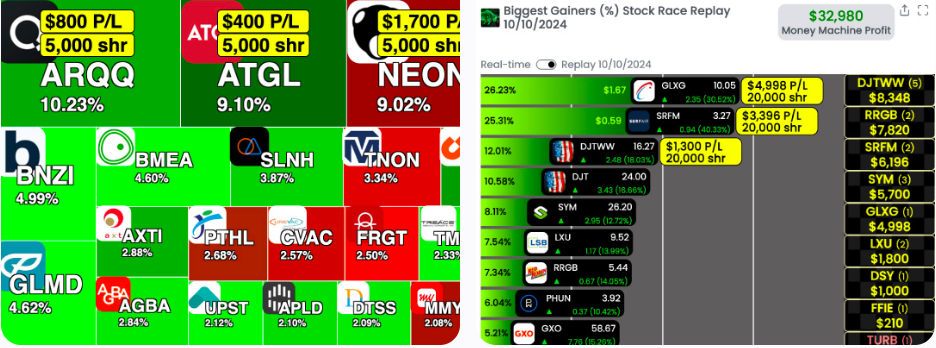20 Recommended Suggestions For Picking AI Stock Trading Sites
20 Recommended Suggestions For Picking AI Stock Trading Sites
Blog Article
Top 10 Suggestions To Evaluate Ai And Machine Learning Models For Ai Stock-Predicting And Analyzing Platforms
It is crucial to evaluate the AI and Machine Learning (ML) models that are used by trading and stock prediction systems. This will ensure that they deliver precise, reliable and useful information. A poorly designed or overhyped model could result in financial losses as well as flawed predictions. Here are 10 best tips to evaluate the AI/ML platforms of these platforms.
1. The model's purpose and approach
A clear objective: Determine if the model was created to be used for trading short-term, long-term investments, sentiment analysis, or risk management.
Algorithm transparency: See if the platform discloses the types of algorithms utilized (e.g. regression or neural networks, decision trees, reinforcement learning).
Customization - Find out whether you can modify the model to fit your investment strategy and risk tolerance.
2. Review the Model Performance Metrics
Accuracy Test the accuracy of the model's predictions. Do not rely solely on this measurement, however, because it can be misleading.
Precision and recall. Evaluate whether the model accurately predicts price changes and reduces false positives.
Risk-adjusted results: Determine the impact of model predictions on profitable trading in the face of the accounting risks (e.g. Sharpe, Sortino etc.).
3. Check the model by Backtesting it
Historical performance: Test the model with historical data to see how it would have performed under different market conditions in the past.
Out-of-sample testing The model should be tested using data it wasn't trained on to prevent overfitting.
Scenario-based analysis involves testing the accuracy of the model under various market conditions.
4. Check for Overfitting
Overfitting signs: Look out for models that perform extremely well with training data, but poorly on unseen data.
Regularization Techniques: Look to see if the platform is using techniques such as dropout or L1/L2 regualization to avoid overfitting.
Cross-validation. Ensure the platform performs cross-validation to assess the generalizability of the model.
5. Assessment Feature Engineering
Relevant features: Ensure that the model includes relevant attributes (e.g. price, volume and technical indicators).
Selected features: Select only those features which are statistically significant. Avoid redundant or irrelevant information.
Dynamic feature updates: Verify whether the model is able to adapt to changes in characteristics or market conditions over time.
6. Evaluate Model Explainability
Model Interpretability: The model needs to be able to provide clear explanations for its predictions.
Black-box models: Be wary of platforms that use excessively complex models (e.g. deep neural networks) with no explainability tools.
User-friendly Insights: Make sure that the platform provides an actionable information in a format traders can easily understand and utilize.
7. Assessing the Model Adaptability
Market conditions change - Check that the model can be adjusted to the changes in market conditions.
Continuous learning: Find out whether the platform continually updates the model to incorporate new information. This could improve the performance.
Feedback loops. Ensure you incorporate user feedback or actual outcomes into the model to improve it.
8. Examine for Bias in the Elections
Data bias: Check whether the information in the training program is accurate and does not show bias (e.g. an bias toward certain industries or time periods).
Model bias - Determine if your platform actively monitors the presence of biases within the model predictions.
Fairness. Check that your model doesn't unfairly favor certain stocks, industries or trading techniques.
9. Evaluate the computational efficiency
Speed: Check whether the model is able to make predictions in real-time, or with a minimum of delay. This is crucial for traders with high frequency.
Scalability: Verify whether the platform can manage huge datasets and a large number of users with no performance loss.
Resource utilization: Find out whether the model is using computational resources effectively.
Review Transparency and Accountability
Model documentation: Verify that the model platform has comprehensive documentation on the model's structure, its training process and its limitations.
Third-party validation: Determine whether the model was independently verified or audited by a third party.
Error handling: Verify whether the platform is equipped to identify and correct model errors or failures.
Bonus Tips
User reviews and Case studies: Review user feedback, and case studies to determine the real-world performance.
Trial period: You can use an unpaid trial or demo to evaluate the model's predictions as well as its the model's usability.
Customer support: Check that the platform provides an extensive customer service to assist you solve any product or technical issues.
Following these tips can help you assess the AI models and ML models on platforms that predict stocks. You will be able determine whether they are honest and trustworthy. They must also be aligned with your goals for trading. Have a look at the most popular ai investment platform recommendations for site recommendations including market ai, investment ai, AI stock trading, ai for stock trading, using ai to trade stocks, incite, AI stocks, ai investing app, using ai to trade stocks, best AI stock and more.
Top 10 Tips For Evaluating The Reviews And Reputations Of Ai Stock Predicting/Analyzing Trading Platforms
For AI-driven platforms that provide trading and stock prediction it is important to check their reputation and reviews. This will guarantee that they are reliable, trustworthy, and effective. Here are 10 suggestions on how to evaluate their reviews and reputation:
1. Check Independent Review Platforms
Read reviews of reliable platforms like G2, copyright, and Capterra.
The reason is that independent platforms allow users to give an honest and objective feedback.
2. Examine testimonials from users as well as case studies
Tips: You can read reviews of users as well as case studies either on the platform's website or third-party sites.
Why: They provide insight into real-world performance as well as user satisfaction and other aspects.
3. Check out industry recognition as well as experts' opinions
Tips: Find out whether any industry experts or analysts that are reputable have viewed the platform or recommended it.
Why? Expert endorsements add credibility for the platform.
4. Social Media Sentiment
Tip: Check social media sites for comments and discussions about the platform (e.g. Twitter, LinkedIn, Reddit).
The reason: Social media provides unfiltered opinions and trends on the platform.
5. Verify compliance with regulations
Tips: Make sure that the platform you use is compliant with the laws on data privacy and financial regulations.
Why: Compliance ensures the platform operates legally and with integrity.
6. Transparency is key in performance measures.
Tips: Make sure the platform has transparent performance metrics like the accuracy of rates, ROI, and backtesting results.
Transparency is essential as it helps build trust and lets users evaluate the effectiveness of the platform.
7. How to Assess Customer Support
Tip: Read reviews about the platform's customer support responsiveness and efficiency.
Why is it important to have reliable support? It's crucial for resolving any issues and ensuring a pleasant customer experience.
8. Red Flags: Check reviews for red flags
Tip Look for repeated complaints. These could be poor performance, hidden charges or lack of updating.
Why: Consistent negative feedback indicates potential problems on the platform.
9. Review user engagement and community
Tips: Check whether the platform interacts with its users regularly and has a lively community.
Why: Strong communities indicate that users are satisfied and continue to show support.
10. Check the company's track record
Explore the past performance of the company as well as its leadership and the overall performance of the financial technology industry.
The reason: A track record improves the confidence in the reliability of the platform and expertise.
Compare different platforms
Compare reviews and reputations from different platforms to find the one that is best suited to your requirements.
By following these tips by following these guidelines, you can carefully evaluate the reputation and reviews of AI stocks prediction and trading platforms. Make sure you select a trustworthy and effective solution. Take a look at the most popular get redirected here on trading ai tool for blog tips including can ai predict stock market, AI stock analysis, ai options trading, ai share trading, ai share trading, ai copyright signals, best ai penny stocks, AI stock investing, stock trading ai, best AI stock prediction and more.